Question
A 50-kilogram person is sitting on a seesaw 1.2 meters from the balance point. On the other side, a 70-kilogram person is balanced. How far from the balance point is the second person sitting?

(A) 0.57 m
(B) 0.75 m
(C) 0.63 m
(D) 0.86 m
▶️Answer/Explanation
Ans:(D) Balanced means the torques are equal and opposite:
50 kg · g · 1.2 = 70 kg · g · x
x = 6/7 = 0.86
Question
A solid sphere \((I=0.06kg\cdot m^{2})\) spins freely around an axis through its center at an angular speed of 20 rad/s. It is desired to bring the sphere to rest by applying a friction force of magnitude 2.0 N to the sphere’s outer surface, a distance of 0.30 m from the sphere’s center. How much time will it take the sphere to come to rest?
(A) 4 s
(B) 2 s
(C) 0.06 s
(D) 0.03 s
▶️Answer/Explanation
Ans:
B—This is a calculation using \(\tau _{net}=Ia\). The net torque on the sphere is force times distance from the center, or (2.0 N)(0.30 m) = 0.60 m∙N. Now the angular acceleration can be calculated: (0.60 m∙N) = (0.06 \(kg\cdot m^{2}\))(a), so a = 10 rad/s per second. Use the definition of angular acceleration: the sphere loses 10 rad/s of speed each second. It started with 20 rad/s of speed, so after 1 s it has 10 rad/s of speed; after 2 s it will have lost all its speed.
Questions (a) and (b) refer to the following information:
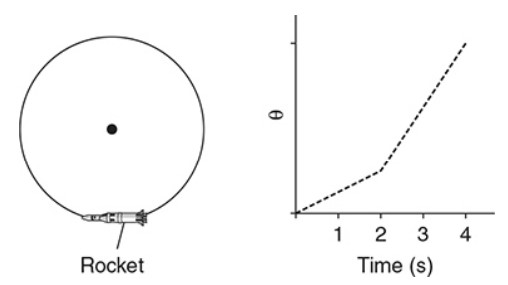
A bicycle wheel of known rotational inertia is mounted so that it rotates clockwise around a vertical axis, as shown in the first figure. Attached to the wheel’s edge is a rocket engine, which applies a clockwise torque τ on the wheel for a duration of 0.10 s as it burns. A plot of the angular position θ of the wheel as a function of time t is shown in the graph.
Question(a)
In addition to the wheel’s rotational inertia and the duration of time the engine burns, which of the following information from the graph would allow determination of the net torque the rocket exerts on the wheel?
(A) The area under the graph between t = 0 s and t = 3 s
(B) The change in the graph’s slope before and after t = 2 s
(C) The vertical axis reading of the graph at t = 3 s
(D) The vertical axis reading of the graph at t = 2 s
▶️Answer/Explanation
Ans:B
Newton’s second law for rotation says \(\tau _{net}=I\alpha\), where α is the angular acceleration, or change in the wheel’s angular velocity per time. To find the wheel’s angular velocity, look at the slope of the angular position versus time graph. The slope changes after the torque is applied; so the change in the slope is the change in the angular velocity, which (when divided by the 0.10 s duration of the rocket firing) gives the angular acceleration.
Question(b)
Which of the following graphs sketches the angular acceleration α of the wheel as a function of time?
(A) 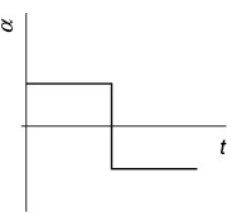
(B) 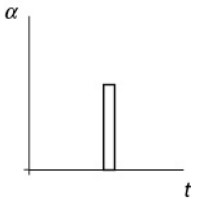
(C) 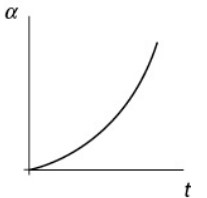
(D) 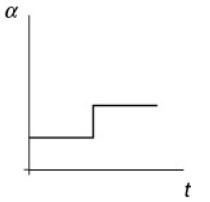
▶️Answer/Explanation
Ans:
B—Angular acceleration is the change in angular speed in each second. To find angular speed, take the slope of the angular position versus time graph shown. This slope is constant for two seconds, then it changes to another constant slope. Therefore, there is no angular acceleration during the time when the slope doesn’t change—with no change in angular speed, there’s no acceleration. The only change in angular speed comes at the moment the slope changes, so that’s the only time when there’s any angular acceleration.
Question: Multiple-Correct Items
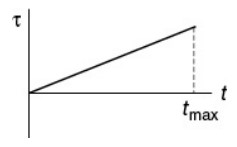
The net torque \(\tau \) on an object of rotational inertia \(I\) is shown as a function of time \(t\). At time \(t_{max}\), the object has speed ω and angular acceleration α. Which of the following methods correctly determine the change in the object’s angular momentum? Select two answers.
(A) Multiply \(I\) by \(\alpha /t_{max}\).
(B) Multiply the average torque by \(t_{max}\).
(C) Calculate the area under the line on the graph.
(D) Multiply \(I\) by ω.
▶️Answer/Explanation
Ans:B and C
Change in angular momentum is τΔt, which means the area under a torque-time graph; thus, choice C is correct. Since this graph is linear, the average torque multiplied by the maximum time is the same thing as the area under the graph, so choice B is also correct. While choice D describes a calculation of angular momentum, it does not correctly give the change in angular momentum, so you don’t know whether the object had an initial angular momentum or not.
Question
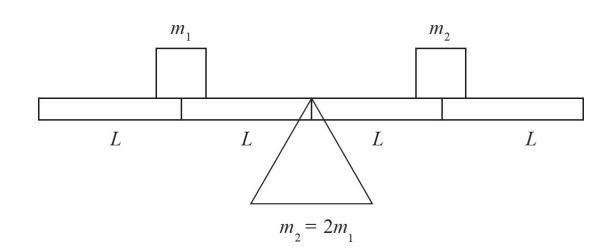
As it is, the system above is not balanced. Which of the following changes would NOT balance the system so that there is 0 net torque? Assume the plank has no mass of its own.
(A) Adding a mass equal to m2 on the far left side and a mass equal to m1 and on the far right side
(B) Stacking both masses directly on top of the fulcrum
(C) Moving the fulcrum a distance L/3 to the right
(D) Moving both masses a distance L/3 to the left
▶️Answer/Explanation
Ans:A
In this situation, the left-hand block will provide counter-clockwise torque, and the right-hand block will provide clockwise torque. Therefore, the two must be equal in magnitude for the system to be balanced. You know that the formula for torque is τ = Frsinθ. In this problem, the θ will always be 90 degrees, and sin90° = 1, so that term will be neglected for the rest of the explanation. Furthermore, the only forces involved in this problem are the forces of gravity on the blocks, and you know \(F_{g}=mg\).
For (A), the net counter-clockwise torque (left side of the system) would be \(\tau =(m_{2}g)(2L)+(m_{1}g)(L)=(2m_{1}g)(2L)+(m_{1}g)(L)=5m_{1}gL\). The clockwise torque (right side of the system) would be \(\tau =(m_{2}g)(L)+(m_{1}g)(2L)=(2m_{1}g)(L)+(m_{1}g)(2L)=4m_{1}gL\). Thus, it would not be balanced. Choice (B) would make both torques 0, so that would be balanced. Choices (C) and (D) both result in the fulcrum being twice as far from \(m_{1}\) as it is from \(m_{2}\), which would counteract the difference in their weights.
